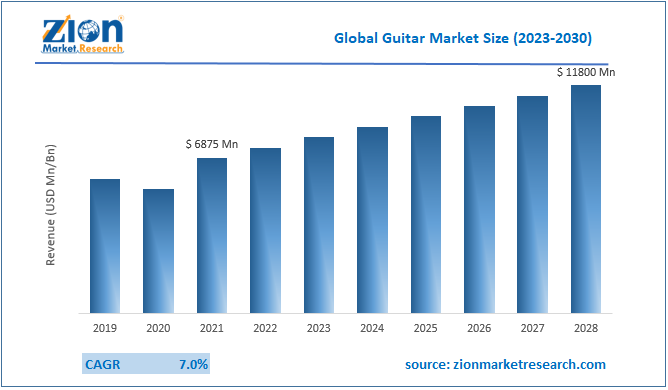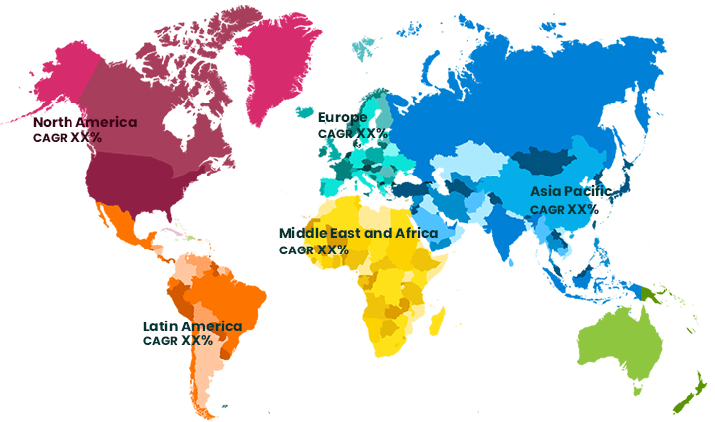Global Guitar Market Size, Share, Growth Analysis Report - Forecast 2034

Guitar Market By Type (Acoustic, Electric, Classical, Bass, Others), By Wooden Material (Mahogany, Maple, Rosewood, Others), Number of Strings (6-String, 7-String, 12-String, Others), String Material (Nylon, Steel, Others), Application (Professional Performance, Learning & Training, Individual Amateurs, Others), and By Region: Global and Regional Industry Overview, Market Intelligence, Comprehensive Analysis, Historical Data, and Forecasts 2025 - 2034
| Market Size in 2024 | Market Forecast in 2034 | CAGR (in %) | Base Year |
|---|---|---|---|
| USD 11.92 Billion | USD 24.75 Billion | 7.58% | 2024 |
Guitar Market: Industry Perspective
The global guitar market size was worth around USD 11.92 Billion in 2024 and is predicted to grow to around USD 24.75 Billion by 2034 with a compound annual growth rate (CAGR) of roughly 7.58% between 2025 and 2034. The report analyzes the global guitar market's drivers, restraints/challenges, and the effect they have on the demands during the projection period. In addition, the report explores emerging opportunities in the guitar industry.
Guitar Market: Overview
The guitar is an extremely popular musical instrument that has consumers across the world and is not specific to a particular region. It is a form of fretted instrument which means that it is composed of thin strips of metal wire, the most commonly used, or other material. The strips are laterally positioned at specific locations along the fretboard or the neck of the stringed guitar. While playing the instrument, the sound can either be projected acoustically or by using a resonant chamber. The sound can be amplified using an amplifier or an electric pickup. Guitar falls under the category of chordophone which is a classification for instruments that use vibrating strings attached along two separate points, to produce sound. Traditionally, the famous instrument was created using wood and strings made of catgut, however with the musical revolution in recent years, guitars made of steel were introduced in the United States where the strings were made of nylon.
Key Insights
- As per the analysis shared by our research analyst, the global guitar market is estimated to grow annually at a CAGR of around 7.58% over the forecast period (2025-2034).
- Regarding revenue, the global guitar market size was valued at around USD 11.92 Billion in 2024 and is projected to reach USD 24.75 Billion by 2034.
- The guitar market is projected to grow at a significant rate due to rising interest in music education, growing popularity of online music content and tutorials, and increasing sales through e-commerce platforms.
- Based on Type, the Acoustic segment is expected to lead the global market.
- On the basis of Wooden Material, the Mahogany segment is growing at a high rate and will continue to dominate the global market.
- Based on the Number of Strings, the 6-String segment is projected to swipe the largest market share.
- By String Material, the Nylon segment is expected to dominate the global market.
- In terms of Application, the Professional Performance segment is anticipated to command the largest market share.
- Based on region, North America is predicted to dominate the global market during the forecast period
To know more about this report, request a sample copy.
Covid-19 Impact
The global cap was positively influenced during the peak of the virus-driven by the lockdown impositions and remote work culture. These factors led to people having more time at hand to explore their hobbies. A lot of companies encouraged employees to showcase their talents while working remotely, as a part of the organization's initiatives to boost their morale and help them navigate through the critical conditions that arose during the pandemic. The global market faced challenges initially because of delays in the supply chain, the absence of raw materials, and other factors but in the long run, the impact seems to be positive.
Guitar Market: Growth Drivers
Remote culture to help propel market growth
The global guitar market is projected to witness a surge in the growth trend owing to the prevalent remote work culture. Covid-19 was a turning point that showed that organizations could function effectively even when the employees were working from home or remotely. As of 2022, even most companies have adopted a hybrid work culture allowing employees to work some of the days of the week from their place of preference. As per Apollo Technical, around 63% of high-income companies currently use hybrid work culture. This trend has allowed employees more time to spend on their habits or explore more areas of interest. Since guitar is one of the most common forms of learning musical instruments, it is also highly preferred as in many cases, it is the first choice of new beginners. It is also relatively easier to learn which acts as a key reason for the high adoption rate.
Guitar Market: Restraints
Longer lifespan of guitar to restrict the market growth
A good-quality guitar, if taken well care of, can last for 10 to 20 years with regular maintenance. The lifespan of the instrument also depends on how frequently it is used along with the kind of treatment it gets. Generally speaking, the lifespan of a guitar is longer which is a restraining factor for market growth since a user will end up buying new guitars after some time has passed. Although this is a key attribute of an excellent quality guitar it does impact the global market cap size eventually.
Guitar Market: Opportunities
Unexplored markets to provide growth opportunities
The global guitar market growth trend can gain more momentum from the unexplored market by undertaking initiatives to promote music and its related aspects. The instrument is a common form but may be expensive for low-income groups or people in emerging economies. This can be resolved by undertaking initiatives to help these groups get access to the instrument helping in increasing consumer database
Guitar Market: Challenges
Presence of other similar forms of instruments to challenge market growth
The global market cap may face certain challenges owing to the presence of multiple other forms of an instrument similar to the guitar. Since the musical device is extremely common, more people are now inclining toward other forms to mark themselves as niche players. This is projected to decline the otherwise growing trend which can be countered by improving and adding other developments in the traditional guitars.
Guitar Market: Segmentation Analysis
The global guitar market is segmented based on Type, Wooden Material, Number of Strings, String Material, Application, and region.
Based on Type, the global guitar market is divided into Acoustic, Electric, Classical, Bass, Others.
On the basis of Wooden Material, the global guitar market is bifurcated into Mahogany, Maple, Rosewood, Others.
By Number of Strings, the global guitar market is split into 6-String, 7-String, 12-String, Others.
In terms of String Material, the global guitar market is categorized into Nylon, Steel, Others.
By Application, the global Guitar market is divided into Professional Performance, Learning & Training, Individual Amateurs, Others.
Recent Developments:
- In January 2019, Fender Musical Instruments Corporation (FMIC), a US-based manufacturer of instruments and amplifiers, announced the launch of a new and hybrid line of acoustic-electric guitars that are manufactured in California.
- In September 2021, the UK witnessed the launch of Instrumental Aluminum Incorporated, a leading company manufacturing environment-friendly guitars. Along with the launch of the company, the UK market will now have access to the organization’s patent-pending hybrid electric guitars made of aluminum.
Guitar Market: Report Scope
| Report Attributes | Report Details |
|---|---|
| Report Name | Guitar Market |
| Market Size in 2024 | USD 11.92 Billion |
| Market Forecast in 2034 | USD 24.75 Billion |
| Growth Rate | CAGR of 7.58% |
| Number of Pages | 172 |
| Key Companies Covered | Fender Musical Instruments Corporation, Gibson Inc., PRS Guitars, B.C. Rich Guitars, C.F. Martin & Co. Inc., The ESP Guitar Company, Godin Guitars, Ibanez Guitars, Samick Guitars, Schecter Guitar Research, Taylor-Listug Inc., Michael Kelly Guitar Co., Yamaha Corporation of America, Yamaha Corporation, and others. |
| Segments Covered | By Type, By Wooden Material, By Number of Strings, By String Material, By Application, and By Region |
| Regions Covered | North America, Europe, Asia Pacific (APAC), Latin America, The Middle East and Africa (MEA) |
| Base Year | 2024 |
| Historical Year | 2020 to 2024 |
| Forecast Year | 2025 to 2034 |
| Customization Scope | Avail customized purchase options to meet your exact research needs. Request For Customization |
Guitar Market: Regional Analysis
North America to lead market growth during the forecast period
The global guitar market is projected to be led by North America in the coming years owing to the high market penetration of guitar manufacturers. The electric guitar was first invented in the US in the 1940s and since then the country has become the hub of guitar players. The US music industry and its world-famous artists, contribute heavily to the regional market growth. The industry along with its players is highly influential where the guitar is a standard and popular part of their music culture. For instance, the guitar of Kurt Donald Cobain, a pioneer in the American music industry, was sold for USD 4.6 million in an auction in May 2020. The global market may also benefit from Asia-Pacific owing to its rising population and the subsequent number of people interested in learning guitar. Even though the instrument is commonly found, with the emergence of schools and other teaching institutes focusing solely on music, it is expected that the region will grow further.
Guitar Market: Competitive Analysis
The report provides a company market share analysis to give a broader overview of the key market players. In addition, the report also covers key strategic developments of the market, including acquisitions & mergers, new product launches, agreements, partnerships, collaborations & joint ventures, research & development, and regional expansion of major participants involved in the guitar market on a global and regional basis.
The global guitar market is dominated by players like:
- Fender Musical Instruments Corporation
- Gibson Inc.
- PRS Guitars
- B.C. Rich Guitars
- C.F. Martin & Co. Inc.
- The ESP Guitar Company
- Godin Guitars
- Ibanez Guitars
- Samick Guitars
- Schecter Guitar Research
- Taylor-Listug Inc.
- Michael Kelly Guitar Co.
- Yamaha Corporation of America
- Yamaha Corporation
The global guitar market is segmented as follows;
By Type
- Acoustic
- Electric
- Classical
- Bass
- Others
By Wooden Material
- Mahogany
- Maple
- Rosewood
- Others
By Number of Strings
- 6-String
- 7-String
- 12-String
- Others
By String Material
- Nylon
- Steel
- Others
By Application
- Professional Performance
- Learning & Training
- Individual Amateurs
- Others
By Region
- North America
- The U.S.
- Canada
- Mexico
- Europe
- France
- The UK
- Spain
- Germany
- Italy
- Rest of Europe
- Asia Pacific
- China
- Japan
- India
- Australia
- South Korea
- Rest of Asia Pacific
- The Middle East & Africa
- Saudi Arabia
- UAE
- Egypt
- Kuwait
- South Africa
- Rest of the Middle East & Africa
- Latin America
- Brazil
- Argentina
- Rest of Latin America
Table Of Content
Methodology
FrequentlyAsked Questions
The global guitar market is expected to grow due to rising interest in music education, digital music production, and the popularity of live and online performances.
According to a study, the global guitar market size was worth around USD 11.92 Billion in 2024 and is expected to reach USD 24.75 Billion by 2034.
The global guitar market is expected to grow at a CAGR of 7.58% during the forecast period.
North America is expected to dominate the guitar market over the forecast period.
Leading players in the global guitar market include Fender Musical Instruments Corporation, Gibson Inc., PRS Guitars, B.C. Rich Guitars, C.F. Martin & Co. Inc., The ESP Guitar Company, Godin Guitars, Ibanez Guitars, Samick Guitars, Schecter Guitar Research, Taylor-Listug Inc., Michael Kelly Guitar Co., Yamaha Corporation of America, Yamaha Corporation, among others.
The report explores crucial aspects of the guitar market, including a detailed discussion of existing growth factors and restraints, while also examining future growth opportunities and challenges that impact the market.
RelatedNews
HappyClients
Zion Market Research
Tel: +1 (302) 444-0166
USA/Canada Toll Free No.+1 (855) 465-4651
3rd Floor,
Mrunal Paradise, Opp Maharaja Hotel,
Pimple Gurav, Pune 411061,
Maharashtra, India
Phone No +91 7768 006 007, +91 7768 006 008
US OFFICE NO +1 (302) 444-0166
US/CAN TOLL FREE +1 (855) 465-4651
Email: sales@zionmarketresearch.com
We have secured system to process your transaction.
Our support available to help you 24 hours a day, five days a week.
Monday - Friday: 9AM - 6PM
Saturday - Sunday: Closed







